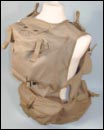I picked up a Load Bearing Vest from the Salvation Army resale shop in Santee, Ca. June 24th, 2005. I had been looking for another vest since my Flax vest wore out and had been considering a convertible/utility type vest - one based on function rather than looks.
I had been telling myself that a military web belt would be the basic field pack, hooking up canteen and canteen pouches to balance the load of water and camera gear. I was envisioning a padded suspender/shoulder harness that could accept modular components.
Lo and behold, there was a military rig laying by itself on the top corner of a couch in the resale shop. $10.50!!!
| This setup has; The padded shoulder harness with four strap clips A back modular mounting panel with two straps to attach to the harnesses back clips Left & right front ammo clip/gernade panels with one strap to attach to the harnesses front clips. The front panels have two adjustable straps with plastic clips to adjust fit, and the side space between the front and back panels are corset stringed for fit. A wide web belt (canteen belt) with eyelets which is strapped to the bottom of the front and rear panels And, a butt pack which attaches to the back panel A whistle and a chemical light stick tied to the shoulder harness A Medic Pin on the butt pack A small amount of dirt |
The rig is heavier than a basic aluminum back-pack frame and nylon pack. But, it fits as close to your body as you wish it to. And the load can be distributed around the torso.
As it is now, it can't haul my gear. Small Pentax lenes will fit the grenade pouches. The digital camera will fit into a clip pouch. A meduim botted water will fit the larger clip pouches. There is plenty of room in the butt pack for day hike stuff.
There will have to be ways to attach tripods and larger lenses, etc., though the butt pack has straps top and bottom for horizontal items (bed rolls). This web belt is rated "medium", for waist sizes thru 36".
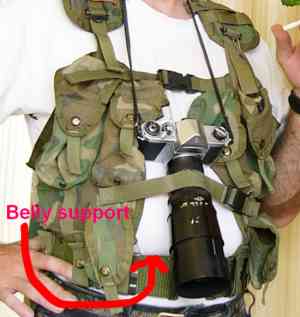 |
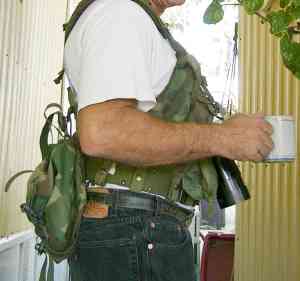 |
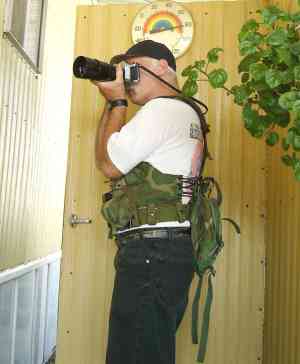 |
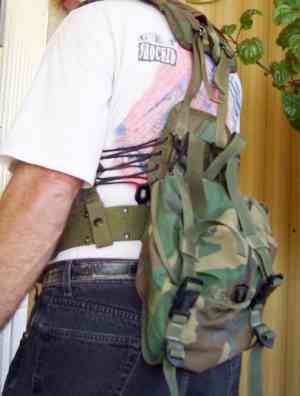 |
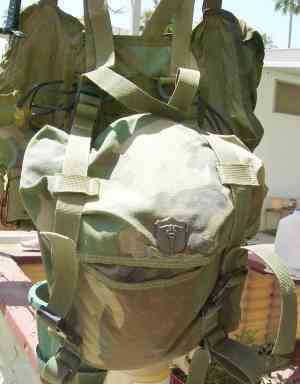 |
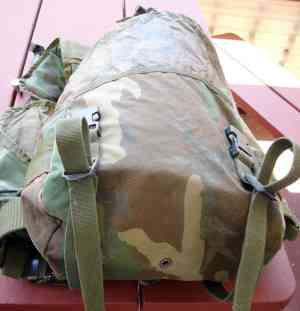 |
Load Bearing Roots
The origin of the modern individual load bearing system dates back to World War II, where the first assault vests were used by American forces during the Normandy invasion. These vests were made from canvas cloth with a number of large pockets on the front and back to accommodate
bulky items such as grenades, demolitions, and ammunition (in addition to what soldiers normally carried on their pistol belts).
|
The Load Bearing Vest (LBV) was the military's first true assault vest. While it still used the pistol belt as the primary load-bearing item, the LBV replaced the suspender straps with a mesh vest, to which ammunition and grenade pockets were sewn into the front chest pieces. The introduction of these pockets freed up space on the pistol belt by eliminating the need for magazine pouches, as well as making magazines more readily accessible.
Ranger-Ready
 The Load Bearing Vest (LBV) in action. |
The RACK (also known as Modular Lightweight Load Carrying System, or MOLLE) was the first system to truly go "vertical" -- not only could the user store equipment in pouches around the waist, but he could also attach it to a "bib" on the chest. More impressively, the user could configure the modular packs that attached to the harness and bib to meet specific mission requirements.
Current Issue
 Big things in a small package: the latest load bearing vest. |
The MOLLE concept has also been incorporated into the military's current issue body armor, the Interceptor OTV, or Outer Tactical Vest. While the OTV and FLC can be worn as separate items, the OTV incorporates the same pouch attachment system as the FLC and RACK, so that all
necessary equipment can be attached directly to the OTV.
Carrying 60 pounds around is no picnic - but with the help of load bearing vests such as the RACK and the FLC and modular pockets, the modern warrior can finally organize his equipment in such a way that he doesn't have to take his eyes off of the fight to get to the tools that
he needs.
ARMY ALICE LC-1 & LC-2 COMBAT FIELD PACKS
Lightweight nylon fabric military equipment packs, pack frames, suspenders, shoulder straps and packing comfort accessories for the field.
ALICE Medium Field Packs have been the Army standard issue since the Vietnam War. Current modifications and use of newer water repellant nylon materials make these packs and accessories very useful and economical load carrying systems for budget
conscious folks. The Medium Pack is used with or without the LC-2 Pack & Cargo Frame. The Large Combat Pack requires use of the frame. Each pack features a large internal packsack and radio compartment, compression straps, external cargo pockets w/cinching buckles, Velcro®
closing top flap with a pocket roomy enough for a 2 or 5 Quart collapsible canteen. Conventional lashing or gear attachment patches are provided. Fabrics are Mil-Spec nylon duck and harness webbing. Shoulder straps sold separately. Made in the USA.
ALICE LC-2 COMBAT 3-DAY TRAINING PACK
Affectionately known as the Butt Pack used for training and carrying 3-day existence loads of clothing and rations. The Training Field Pack is just like the older U.S. military issue canvas 3-day pack. It attaches to individual equipment belt and
accepts shoulder suspenders at rear "D" rings for heavy loading.
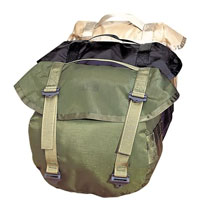
SPECS:
Water repellent collar that folds over contents
Carry handle
External 1'' web straps for attaching sleeping gear or cinching
Plastic document pouch is easily accessible at the rear
Attaches to equipment belt and suspenders
420 deinier nylon packcloth fabric
Measures: 10-1/4'' W x 9-9/16'' x 6-1/4'' (26x24x16cm)
Made in USA.


